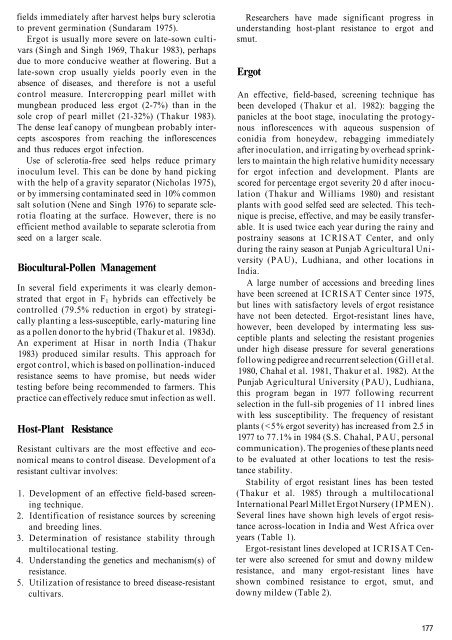RA 00110.pdf - OAR@ICRISAT
RA 00110.pdf - OAR@ICRISAT
RA 00110.pdf - OAR@ICRISAT
You also want an ePaper? Increase the reach of your titles
YUMPU automatically turns print PDFs into web optimized ePapers that Google loves.
fields immediately after harvest helps bury sclerotia<br />
to prevent germination (Sundaram 1975).<br />
Ergot is usually more severe on late-sown cultivars<br />
(Singh and Singh 1969, Thakur 1983), perhaps<br />
due to more conducive weather at flowering. But a<br />
late-sown crop usually yields poorly even in the<br />
absence of diseases, and therefore is not a useful<br />
control measure. Intercropping pearl millet with<br />
mungbean produced less ergot (2-7%) than in the<br />
sole crop of pearl millet (21-32%) (Thakur 1983).<br />
The dense leaf canopy of mungbean probably intercepts<br />
ascospores from reaching the inflorescences<br />
and thus reduces ergot infection.<br />
Use of sclerotia-free seed helps reduce primary<br />
inoculum level. This can be done by hand picking<br />
with the help of a gravity separator (Nicholas 1975),<br />
or by immersing contaminated seed in 10% common<br />
salt solution (Nene and Singh 1976) to separate sclerotia<br />
floating at the surface. However, there is no<br />
efficient method available to separate sclerotia from<br />
seed on a larger scale.<br />
Biocultural-Pollen Management<br />
In several field experiments it was clearly demonstrated<br />
that ergot in F 1 hybrids can effectively be<br />
controlled (79.5% reduction in ergot) by strategically<br />
planting a less-susceptible, early-maturing line<br />
as a pollen donor to the hybrid (Thakur et al. 1983d).<br />
An experiment at Hisar in north India (Thakur<br />
1983) produced similar results. This approach for<br />
ergot control, which is based on pollination-induced<br />
resistance seems to have promise, but needs wider<br />
testing before being recommended to farmers. This<br />
practice can effectively reduce smut infection as well.<br />
Host-Plant Resistance<br />
Resistant cultivars are the most effective and economical<br />
means to control disease. Development of a<br />
resistant cultivar involves:<br />
1. Development of an effective field-based screening<br />
technique.<br />
2. Identification of resistance sources by screening<br />
and breeding lines.<br />
3. Determination of resistance stability through<br />
multilocational testing.<br />
4. Understanding the genetics and mechanism(s) of<br />
resistance.<br />
5. Utilization of resistance to breed disease-resistant<br />
cultivars.<br />
Researchers have made significant progress in<br />
understanding host-plant resistance to ergot and<br />
smut.<br />
Ergot<br />
An effective, field-based, screening technique has<br />
been developed (Thakur et al. 1982): bagging the<br />
panicles at the boot stage, inoculating the protogynous<br />
inflorescences with aqueous suspension of<br />
conidia from honeydew, rebagging immediately<br />
after inoculation, and irrigating by overhead sprinklers<br />
to maintain the high relative humidity necessary<br />
for ergot infection and development. Plants are<br />
scored for percentage ergot severity 20 d after inoculation<br />
(Thakur and Williams 1980) and resistant<br />
plants with good selfed seed are selected. This technique<br />
is precise, effective, and may be easily transferable.<br />
It is used twice each year during the rainy and<br />
postrainy seasons at ICRISAT Center, and only<br />
during the rainy season at Punjab Agricultural University<br />
(PAU), Ludhiana, and other locations in<br />
India.<br />
A large number of accessions and breeding lines<br />
have been screened at ICRISAT Center since 1975,<br />
but lines with satisfactory levels of ergot resistance<br />
have not been detected. Ergot-resistant lines have,<br />
however, been developed by intermating less susceptible<br />
plants and selecting the resistant progenies<br />
under high disease pressure for several generations<br />
following pedigree and recurrent selection (Gill et al.<br />
1980, Chahal et al. 1981, Thakur et al. 1982). At the<br />
Punjab Agricultural University (PAU), Ludhiana,<br />
this program began in 1977 following recurrent<br />
selection in the full-sib progenies of 11 inbred lines<br />
with less susceptibility. The frequency of resistant<br />
plants (

















